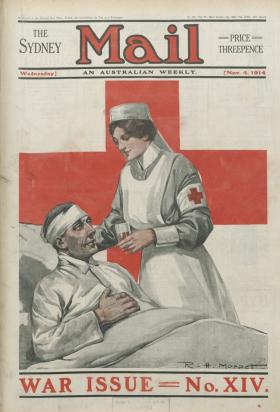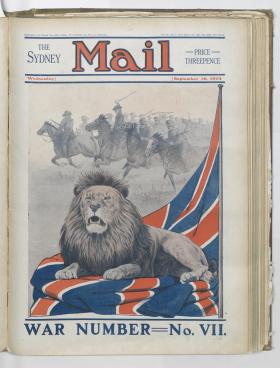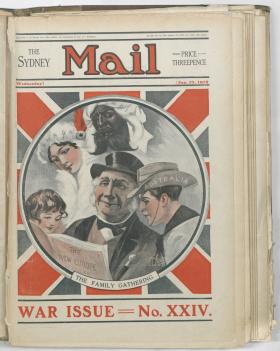Persuasion and media bias
Key inquiry question #1
Covers of The Sydney Mail 1860–1938
Text type
- Persuasive
Background notes for teachers and students
Learning intentions:
Students are learning to:
- recognise when the media is using persuasive techniques to influence a reader’s response to the news.
- reflect on their understanding of media bias and apply it in their own life.
Success criteria
Students will be successful when they can:
- Recognise persuasive techniques used in media texts.
- Analyse the impact of persuasive devices used in media texts..
- Use persuasive devices when creating own media text.
- Reflect on new knowledge.
The Sydney Mail
The Sydney Mail was a weekly magazine published in Sydney from 1860 to 1938.
The State Library has digitised the covers from The Sydney Mail for the period of WWI and they provide a unique insight into how the war was reported at the time.
The media in World War I
The media presented a jingoistic view of the war, often using strong, heroic images which glorified Australia’s involvement in the war. People at home were protected from the realities of war and were instead encouraged to support the war effort and to share the view that the war was an exciting adventure for Australian soldiers. This type of media coverage was used as a way of encouraging recruitment, and to prevent readers from feeling fear and despair over the events unfolding in Europe.
Glossary of terms
Framing: The way in which elements in a still or moving image are arranged to create a specific interpretation of the whole. Strong framing creates a sense of enclosure around elements while weak framing creates a sense of openness.
Gaze: The directed look of either a viewer or figure in an image, including demand and offer.
Salience: A strategy of emphasis, highlighting what is important in a text. In images, salience is created through strategies like placement of an item in the foreground, size, and contrast in tone or colour. In writing, salience can occur through placing what is important at the beginning or at the end of a sentence or paragraph or through devices such as underlining or italics.
Symbol: An object, animate or inanimate, which represents something else through the use of association, intentional analogy and convention.
Vector: An item that directs our eyes towards a focal point, for example when the subject in a visual text is pointing or looking in a certain direction. As the reader or viewer, our eyes will follow the direction in which they are pointing or looking.
NSW Standards Authority Glossary
Student Activities
In the news
Students form groups and work together to analyse the persuasive techniques used on the front cover of The Sydney Mail. They will discuss how these front covers would have influenced readers at the time.

Design your own front-page news
Students use persuasive techniques to create the front cover of a fictional newspaper, drawing upon real recent news stories or developing a fictional newsworthy event.

Reflection
Students are to reflect on what they have learnt about media bias and the persuasive language and visual techniques used by the media to influence readers. They are to use their own device to record a video log.

Additional resources
Google Cultural Institute Life Interrupted: from Civilian to Soldier
NSW Syllabus for the Australian Curriculum: English K-10
A student:
- EN4-RVL-01 uses a range of personal, creative and critical strategies to read texts that are complex in their ideas and construction
- EN4-URA-01 analyses how meaning is created through the use of and response to language forms, features and structures
- EN4-URB-01 examines and explains how texts represent ideas, experiences and values
- EN4-ECA-01 creates personal, creative and critical texts for a range of audiences by using linguistic and stylistic conventions of language to express ideas
- EN4-ECB-01 uses processes of planning, monitoring, revising and reflecting to support and develop composition of texts
Students will:
EN4-RVL-01
- Apply reading pathways to determine form, purpose and meaning
- Revisit texts to develop a clear understanding of the themes, ideas and attitudes they express
- Explore the main ideas and thematic concerns posed by a text for meaning
- Engage with the ways texts contain layers of meaning, or multiple meanings
- Identify and understand that relevant prior knowledge and personal experience enables and enhances understanding when reading, viewing or listening to texts
- Read texts selected to challenge thinking, develop interest and promote enjoyment, to prompt a personal response
- Reflect on how an understanding of texts can be enhanced through re-reading and close study
- Reflect on how reading promotes a broad and balanced understanding of the world and enables students to explore universal issues
EN4-URA-01
- Explore how language and text are acts of representation that range from objective to subjective and may offer layers of literal or implied meanings, and apply this understanding in own texts
- Use appropriate metalanguage to describe how meaning is constructed through linguistic and stylistic elements in texts
- Understand how language forms, features and structures, in a variety of texts, vary according to context, purpose and audience, and demonstrate this understanding through written, spoken, visual and multimodal responses
- Analyse how texts can draw on the codes and conventions of a range of modes and media to shape new meanings, and demonstrate this understanding in own texts
- Analyse how figurative language and devices can represent ideas, thoughts and feelings to communicate meaning
- Recognise how texts engage and position the audience to perceive events, characters and ideas using narrative voice and focalisers, tense, sequencing and intrusion, and apply this understanding in own texts
EN4-URB-01
- Understand how repetition, patterning and language features used within a text communicate ideas about social, personal, ethical and philosophical issues and experiences, and demonstrate this understanding through written, spoken, visual and multimodal responses
- Understand how perspectives are shaped by language and text
- Explore how the perspectives of audiences shape engagement with, and response to, texts
- Examine how elements of personal and social contexts can inform the perspective and purpose of texts and influence creative decisions
- Consider the influence of cultural context on language
- Understand how argument in text is constructed through specific language forms, features and structures, and apply this understanding in own texts
- Explain how the subjectivity or objectivity of arguments in texts is constructed through specific language forms, features and structures, and reflect on these in own texts
- Select and sequence appropriate evidence from texts and reliable sources to support arguments and build authority
- Describe the distinctive rhetorical and aesthetic qualities of a text that contribute to its textual style, and reflect on these qualities in own texts
EN4-ECA-01
- Apply codes and conventions of written, spoken, visual and multimodal texts to enhance meaning and create tone, atmosphere and mood
- Compose visual and multimodal texts to represent ideas, experiences and values
- Select modal elements to work together to support meaning or shape reader response
- Communicate information, ideas and viewpoints using verbal and/or nonverbal language, including gestural features, to enhance and clarify meaning
- Deliver spoken, signed or communicated texts with effective control of intonation, emphasis, volume, pace and timing
- Participate in informal discussions about texts and ideas, including speculative and exploratory talk, to consolidate personal understanding and generate new ideas
- Use features of gesture, manner and voice to signal the progression and development of ideas through language and structure
EN4-ECB-01
- Engage with the features and structures of model texts to plan and consider implications for own text creation
- Reflect on own composition of texts, using appropriate technical vocabulary to explain choices of language and structure in line with the target audience and intended purpose
- Describe the pleasures, challenges and successes experienced in the processes of understanding and composing texts
- Consider how purposeful compositional choices are influenced by specific elements of model texts
- Reflect on own ability to plan, monitor and revise during the composition process, and how this shapes clarity and effect
In each year of Stage 3 students must study examples of:
- print texts
- visual texts
Across the stage, the selection of texts must give students experience of:
- everyday and community texts
- an wide range of factual texts that represent information, issues and ideas
Learning across the curriculum
General Capabilities:
- creative and critical thinking
- literacy